Impact of Impregnation pH on NiMo Surface Species in Al2O3-Supported Catalysts for Green Diesel Production
Abstract
1. Introduction
2. Materials and Methods
2.1. Synthesis of the Support (SG)
2.2. Synthesis of the NiMo Catalyst Supported on SG
2.3. Characterization Techniques
2.4. Catalytic Evaluation
3. Results
3.1. Surface Characterization
3.2. Catalyst Characterization at the Oxide State
3.2.1. UV-Vis DRS Analysis
3.2.2. FT-IR Analysis
3.2.3. Raman Analysis
3.3. Catalyst Characterization at the Sulfide State
TEM Analysis
3.4. Hydroprocessing of Soybean Oil
4. Discussion
4.1. Effect of NiMo Surface Species on the Hydroprocessing of Soybean Oil
4.2. Future Research Directions
- Catalyst design and optimization: A crucial aspect of improving HVO production is the development of more efficient catalysts. This includes investigating metal support interactions, optimizing metal loading, and exploring the use of other types of promotors or alternative active phases.
- Alternative feedstocks: The use of alternative feedstocks, such as canola or palm oils, may improve the quality of green diesel. Moreover, using lignocellulosic biomass for biofuel production offers the potential for increasing sustainability.
- Waste feedstocks: The use of waste feedstocks, such as used cooking oils, could provide a more cost-effective alternative for HVO.
5. Conclusions
Author Contributions
Funding
Institutional Review Board Statement
Informed Consent Statement
Data Availability Statement
Acknowledgments
Conflicts of Interest
References
- Lucantonio, S.; Di Giuliano, A.; Rossi, L.; Gallucci, K. Green Diesel Production via Deoxygenation Process: A Review. Energies 2023, 16, 844. [Google Scholar] [CrossRef]
- Chia, S.R.; Nomanbhay, S.; Chew, K.W.; Show, P.L.; Milano, J.; Shamsuddin, A.H. Indigenous Materials as Catalyst Supports for Renewable Diesel Production in Malaysia. Energies 2022, 15, 2835. [Google Scholar] [CrossRef]
- Khan, S.; Paliwal, V.; Pandey, V.V.; Kumar, V. Biomass as Renewable Energy. Int. Adv. Res. J. Sci. Eng. Technol. 2015, 2, 301–304. [Google Scholar]
- Perlack, R.D.; Wright, L.L.; Turhollow, A.F.; Graham, R.L.; Stoke, B.J.; Erbach, D.C. Biomass as a Feedstock for a Bioenergy and Bioproducts Industry: The Technical Feasibility of a Billion-Ton Annual Supply; Oak Ridge National Laboratory: Oak Ridge, TN, USA, 2005. [Google Scholar] [CrossRef]
- Hongloi, N.; Prapainainar, P.; Prapainainar, C. Review of Green Diesel Production from Fatty Acid Deoxygenation over Ni-Based Catalysts. Mol. Catal. 2022, 523, 111696. [Google Scholar] [CrossRef]
- Mahdi, H.I.; Bazargan, A.; McKay, G.; Azelee, N.I.W.; Meili, L. Catalytic Deoxygenation of Palm Oil and Its Residue in Green Diesel Production: A Current Technological Review. Chem. Eng. Res. Des. 2021, 174, 158–187. [Google Scholar] [CrossRef]
- Li, D.-C.; Pan, Z.; Tian, Z.; Zhang, Q.; Deng, X.; Jiang, H.; Wang, G.-H. Frustrated Lewis Pair Catalyst Realizes Efficient Green Diesel Production. Nat. Commun. 2024, 15, 3172. [Google Scholar] [CrossRef]
- Knothe, G. Biodiesel and Renewable Diesel: A Comparison. Prog. Energy Combust. Sci. 2010, 36, 364–373. [Google Scholar] [CrossRef]
- Wagenhofer, M.F.; Baráth, E.; Gutiérrez, O.Y.; Lercher, J.A. Carbon-Carbon Bond Scission Pathways in the Deoxygenation of Fatty Acids on Transition-Metal Sulfides. ACS Catal. 2017, 7, 1068–1076. [Google Scholar] [CrossRef]
- Jęczmionek, Ł.; Krasodomski, W. Hydroconversion of Vegetable Oils Isomerized over ZSM-5: Composition and Properties of Hydroraffinates. Energy Fuels 2015, 29, 3739–3747. [Google Scholar] [CrossRef]
- Durgut, M.R. Optimized Biodiesel Production from Pumpkin (Cucurbita pepo L.) Seed Oil: A Response Surface Methodology for Microwave-Assisted Transesterification. Processes 2025, 13, 572. [Google Scholar] [CrossRef]
- Huber, G.W.; O’Connor, P.; Corma, A. Processing Biomass in Conventional Oil Refineries: Production of High Quality Diesel by Hydrotreating Vegetable Oils in Heavy Vacuum Oil Mixtures. Appl. Catal. A Gen. 2007, 329, 120–129. [Google Scholar] [CrossRef]
- Kim, S.K.; Han, J.Y.; Lee, H.S.; Yum, T.; Kim, Y.; Kim, J. Production of Renewable Diesel via Catalytic Deoxygenation of Natural Triglycerides: Comprehensive Understanding of Reaction Intermediates and Hydrocarbons. Appl. Energy 2014, 116, 199–205. [Google Scholar] [CrossRef]
- Szarvas, T.; Eller, Z.; Kasza, T.; Ollár, T.; Tétényi, P.; Hancsók, J. Radioisotopic Investigation of the Oleic Acid-1-14C HDO Reaction Pathways on Sulfided Mo/P/Al2O3 and NiW/Al2O3 Catalysts. Appl. Catal. B 2015, 165, 245–252. [Google Scholar] [CrossRef]
- Ameen, M.; Azizan, M.T.; Yusup, S.; Ramli, A.; Yasir, M. Catalytic Hydrodeoxygenation of Triglycerides: An Approach to Clean Diesel Fuel Production. Renew. Sustain. Energy Rev. 2017, 80, 1072–1088. [Google Scholar] [CrossRef]
- Ishihara, A.; Fukui, N.; Nasu, H.; Hashimoto, T. Hydrocracking of Soybean Oil Using Zeolite–Alumina Composite Supported NiMo Catalysts. Fuel 2014, 134, 611–617. [Google Scholar] [CrossRef]
- Rivera-Guasco, R.; López-Benítez, A.; Guevara-Lara, A. Ni-W Catalysts Supported on TiO2-Al2O3 for Efficient Green Diesel Production: “Standard” vs “Keggin” Comparison. ACS Omega 2025, 10, 4276–4290. [Google Scholar] [CrossRef] [PubMed]
- Itthibenchapong, V.; Srifa, A.; Kaewmeesri, R.; Kidkhunthod, P.; Faungnawakij, K. Deoxygenation of Palm Kernel Oil to Jet Fuel-like Hydrocarbons Using Ni-MoS2/γ-Al2O3 Catalysts. Energy Convers. Manag. 2017, 134, 188–196. [Google Scholar] [CrossRef]
- Liu, S.; Zhu, Q.; Guan, Q.; He, L.; Li, W. Bio-Aviation Fuel Production from Hydroprocessing Castor Oil Promoted by the Nickel-Based Bifunctional Catalysts. Bioresour. Technol. 2015, 183, 93–100. [Google Scholar] [CrossRef]
- Hancsók, J.; Kasza, T.; Kovács, S.; Solymosi, P.; Holló, A. Production of Bioparaffins by the Catalytic Hydrogenation of Natural Triglycerides. J. Clean. Prod. 2012, 34, 76–81. [Google Scholar] [CrossRef]
- Kumar, R.; Farooqui, S.A.; Anand, M.; Kumar, R.; Joshi, R.; Khan, A.; Sinha, A.K. Hydrotreatment of Jatropha Oil over NiMoS Catalyst Supported on Thermostable Mesoporous Silica Doped Titania for the Production of Renewable Drop-in Diesel. Catal. Commun. 2017, 98, 102–106. [Google Scholar] [CrossRef]
- Kordouli, E.; Sygellou, L.; Kordulis, C.; Bourikas, K.; Lycourghiotis, A. Probing the Synergistic Ratio of the NiMo/γ-Al2O3 Reduced Catalysts for the Transformation of Natural Triglycerides into Green Diesel. Appl. Catal. B 2017, 209, 12–22. [Google Scholar] [CrossRef]
- Liu, Y.; Sotelo-Boyás, R.; Murata, K.; Minowa, T.; Sakanishi, K. Hydrotreatment of Vegetable Oils to Produce Bio-Hydrogenated Diesel and Liquefied Petroleum Gas Fuel over Catalysts Containing Sulfided Ni–Mo and Solid Acids. Energy Fuels 2011, 25, 4675–4685. [Google Scholar] [CrossRef]
- Mikulec, J.; Cvengroš, J.; Joríková, Ľ.; Banič, M.; Kleinová, A. Second Generation Diesel Fuel from Renewable Sources. J. Clean. Prod. 2010, 18, 917–926. [Google Scholar] [CrossRef]
- López-Benítez, A.; Berhault, G.; Guevara-Lara, A. NiMo Catalysts Supported on Mn-Al2O3 for Dibenzothiophene Hydrodesulfurization Application. Appl. Catal. B 2017, 213, 28–41. [Google Scholar] [CrossRef]
- Bui, N.Q.; Geantet, C.; Berhault, G. Maleic Acid, an Efficient Additive for the Activation of Regenerated CoMo/Al2O3 Hydrotreating Catalysts. J. Catal. 2015, 330, 374–386. [Google Scholar] [CrossRef]
- López-Benítez, A.; Berhault, G.; Guevara-Lara, A. Addition of Manganese to Alumina and Its Influence on the Formation of Supported NiMo Catalysts for Dibenzothiophene Hydrodesulfurization Application. J. Catal. 2016, 344, 59–76. [Google Scholar] [CrossRef]
- Fan, Y.; Xiao, H.; Shi, G.; Liu, H.; Qian, Y.; Wang, T.; Gong, G.; Bao, X. Citric Acid-Assisted Hydrothermal Method for Preparing NiW/USY–Al2O3 Ultradeep Hydrodesulfurization Catalysts. J. Catal. 2011, 279, 27–35. [Google Scholar] [CrossRef]
- Eijsbouts, S.; Van Den Oetelaar, L.C.A.; Van Puijenbroek, R.R. MoS2 Morphology and Promoter Segregation in Commercial Type 2 Ni–Mo/Al2O3 and Co–Mo/Al2O3 Hydroprocessing Catalysts. J. Catal. 2005, 229, 352–364. [Google Scholar] [CrossRef]
- López-Benítez, A.; Guevara-Lara, A.; Berhault, G. Nickel-Containing Polyoxotungstates Based on [PW9O34]9– and [PW10O39]13– Keggin Lacunary Anions Supported on Al2O3 for Dibenzothiophene Hydrodesulfurization Application. ACS Catal. 2019, 9, 6711–6727. [Google Scholar] [CrossRef]
- Guevara-Lara, A.; Bacaud, R.; Vrinat, M. Highly Active NiMo/TiO2-Al2O3 Catalysts: Influence of the Preparation and the Activation Conditions on the Catalytic Activity. Appl. Catal. A Gen. 2007, 328, 99–108. [Google Scholar] [CrossRef]
- Hunter, R.J. Chapter 2—Charge and Potential Distribution at Interfaces. In Zeta Potential in Colloid Science; Hunter, R.J., Ed.; Academic Press: Cambridge, MA, USA, 1981; pp. 11–58. ISBN 978-0-12-361961-7. [Google Scholar]
- Khaleel, A.; Al-Mansouri, S. Meso-Macroporous γ-Alumina by Template-Free Sol–Gel Synthesis: The Effect of the Solvent and Acid Catalyst on the Microstructure and Textural Properties. Colloids Surf. A Physicochem. Eng. Asp. 2010, 369, 272–280. [Google Scholar] [CrossRef]
- Thommes, M.; Kaneko, K.; Neimark, A.V.; Olivier, J.P.; Rodriguez-Reinoso, F.; Rouquerol, J.; Sing, K.S.W. Physisorption of Gases, with Special Reference to the Evaluation of Surface Area and Pore Size Distribution (IUPAC Technical Report). Pure Appl. Chem. 2015, 87, 1051–1069. [Google Scholar] [CrossRef]
- Fournier, M.; Thouvenot, R.; Rocchiccioli-Deltcheff, C. Catalysis by Polyoxometalates. Part 1—Supported Polyoxoanions of the Keggin Structure: Spectroscopic Study (IR, Raman, UV) of Solutions Used for Impregnation. J. Chem. Soc. Faraday Trans. 1991, 87, 349–356. [Google Scholar] [CrossRef]
- Iova, F.; Trutia, A. On the Structure of the NiO–Al2O3 Systems, Studied by Diffuse-Reflectance Spectroscopy. Opt. Mater. 2000, 13, 455–458. [Google Scholar] [CrossRef]
- Jocono, M.L.; Schiavello, M.; Cimino, A. Structural, Magnetic, and Optical Properties of Nickel Oxide Supported on η- and η-γ-Aluminas. J. Phys. Chem. 1971, 75, 1044–1050. [Google Scholar] [CrossRef]
- Lepetit, C.; Che, M. Discussion on the Coordination of Ni2+ Ions to Lattice Oxygens in Calcined Faujasite-Type Zeolites Followed by Diffuse Reflectance Spectroscopy. J. Phys. Chem. 1996, 100, 3137–3143. [Google Scholar] [CrossRef]
- Teixeira da Silva, V.L.S.; Frety, R.; Schmal, M. Activation and Regeneration of a NiMo/Al2O3 Hydrotreatment Catalyst. Ind. Eng. Chem. Res. 1994, 33, 1692–1699. [Google Scholar] [CrossRef]
- Wachs, I.E. Raman and IR Studies of Surface Metal Oxide Species on Oxide Supports: Supported Metal Oxide Catalysts. Catal. Today 1996, 27, 437–455. [Google Scholar] [CrossRef]
- Wachs, I.E. Infrared Spectroscopy of Supported Metal Oxide Catalysts. Colloids Surf. A Physicochem. Eng. Asp. 1995, 105, 143–149. [Google Scholar] [CrossRef]
- Imamura, S.; Sasaki, H.; Shono, M.; Kanai, H. Structure of Molybdenum Supported on α-, γ-, and χ-Aluminas in Relation to Its Epoxidation Activity. J. Catal. 1998, 177, 72–81. [Google Scholar] [CrossRef]
- Nova, I.; Castoldi, L.; Lietti, L.; Tronconi, E.; Forzatti, P.; Prinetto, F.; Ghiotti, G. NOx Adsorption Study over Pt–Ba/Alumina Catalysts: FT-IR and Pulse Experiments. J. Catal. 2004, 222, 377–388. [Google Scholar] [CrossRef]
- Seguin, L.; Figlarz, M.; Cavagnat, R.; Lassègues, J.C. Infrared and Raman Spectra of MoO3 Molybdenum Trioxides and MoO3XH2O Molybdenum Trioxide Hydrates. Spectrochim. Acta A Mol. Biomol. Spectrosc. 1995, 51, 1323–1344. [Google Scholar] [CrossRef]
- Stencel, J.M. Raman Spectroscopy for Catalysis; Van Nostrand Reinhold; Springer: New York, NY, USA, 1990. [Google Scholar]
- Dieterle, M.; Weinberg, G.; Mestl, G. Raman Spectroscopy of Molybdenum Oxides Part I. Structural Characterization of Oxygen Defects in MoO3−x by DR UV/VIS, Raman Spectroscopy and X-Ray Diffraction. Phys. Chem. Chem. Phys. 2002, 4, 812–821. [Google Scholar] [CrossRef]
- Prangklang, D.; Tumnantong, D.; Yoosuk, B.; Ngamcharussrivichai, C.; Prasassarakich, P. Selective Deoxygenation of Waste Cooking Oil to Diesel-Like Hydrocarbons Using Supported and Unsupported NiMoS2 Catalysts. ACS Omega 2023, 8, 40921–40933. [Google Scholar] [CrossRef]
- Topsøe, H. The Role of Co-Mo-S Type Structures in Hydrotreating Catalysts. Appl. Catal. A Gen. 2007, 322, 3–8. [Google Scholar] [CrossRef]
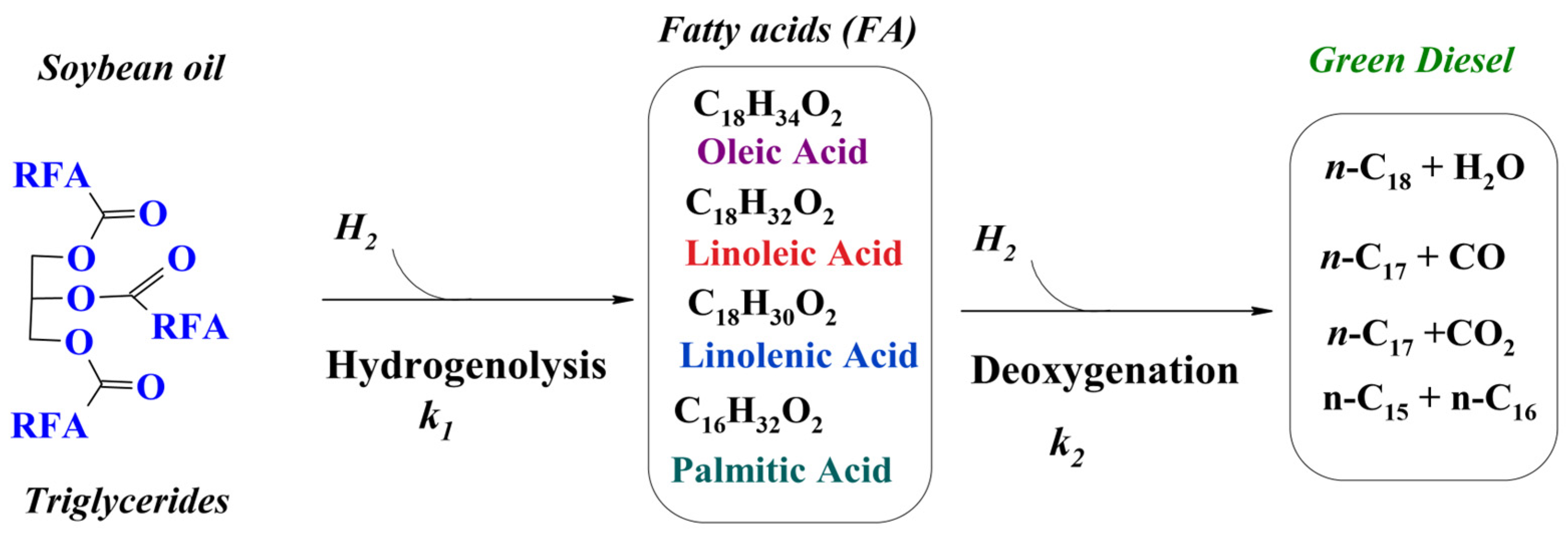

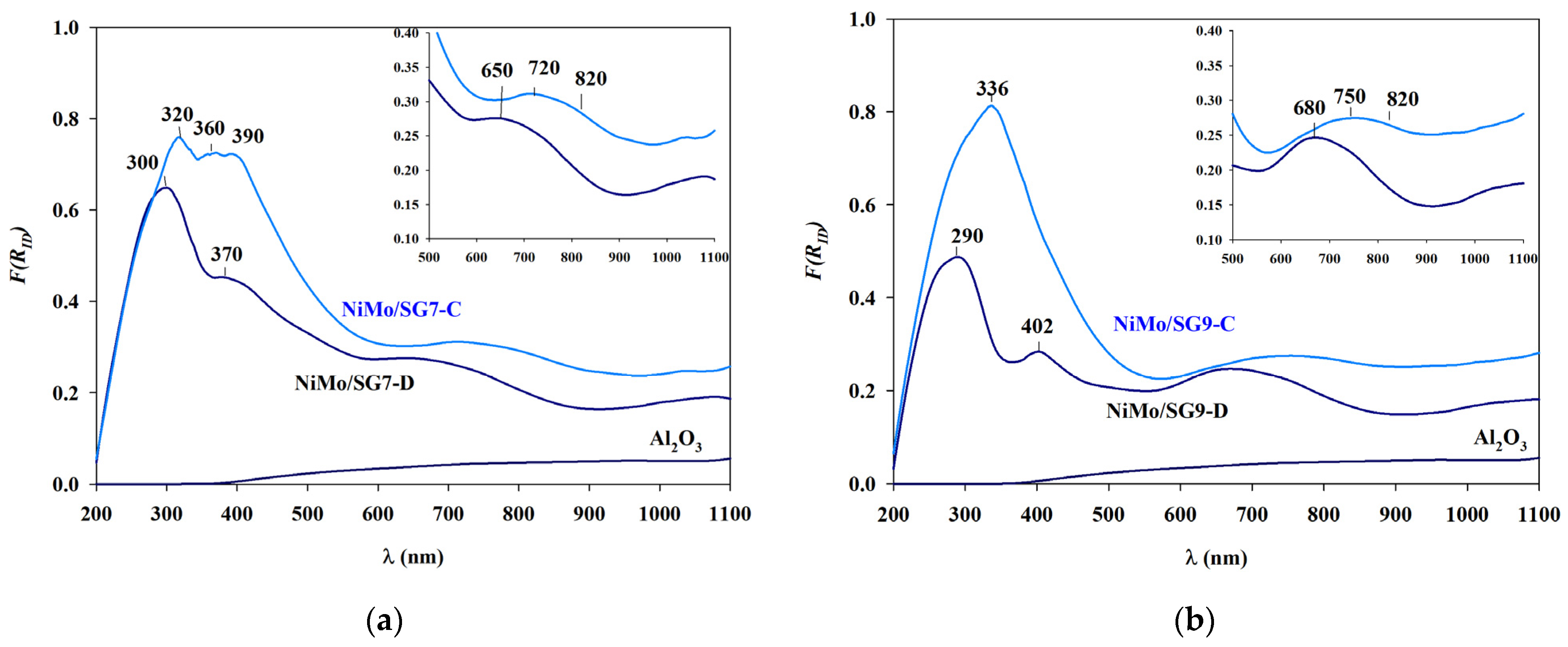
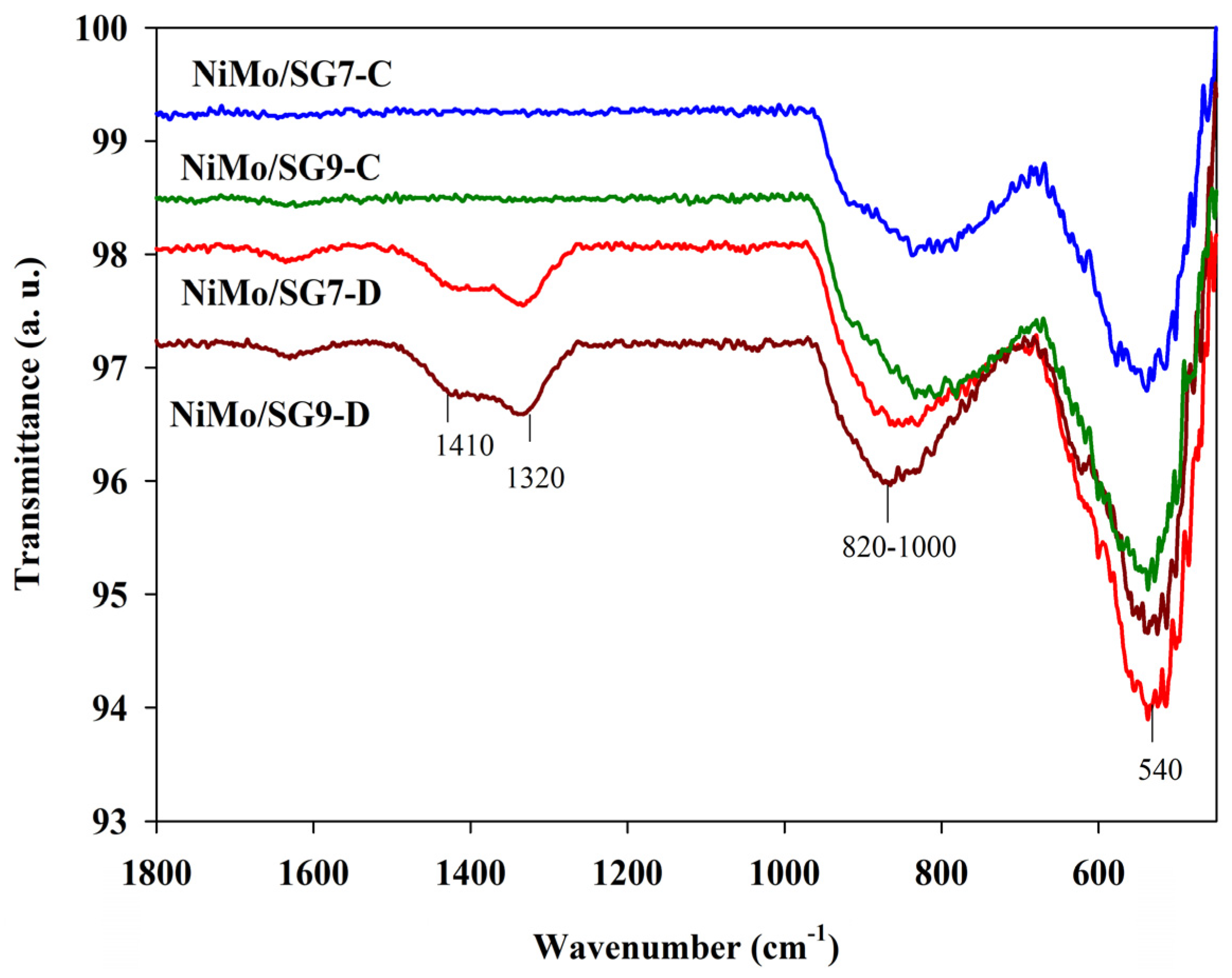
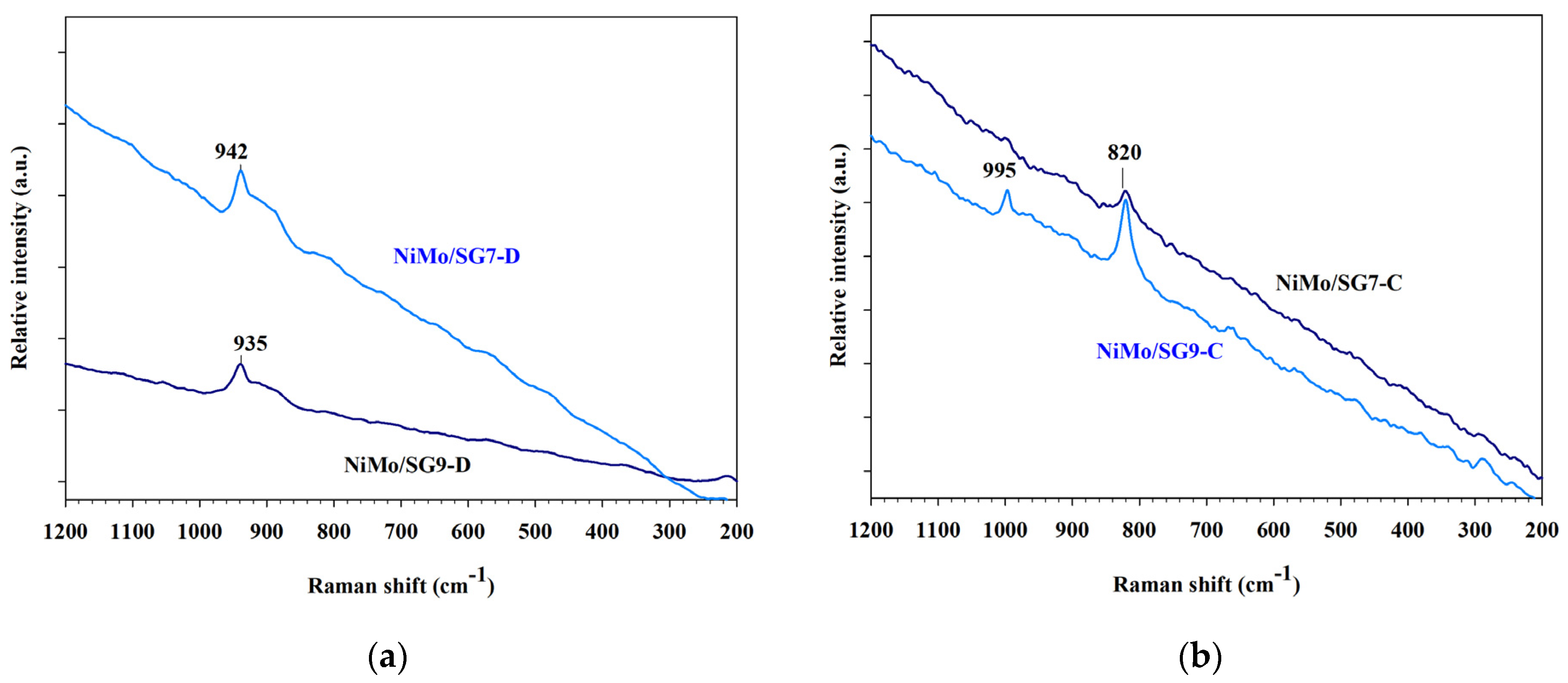
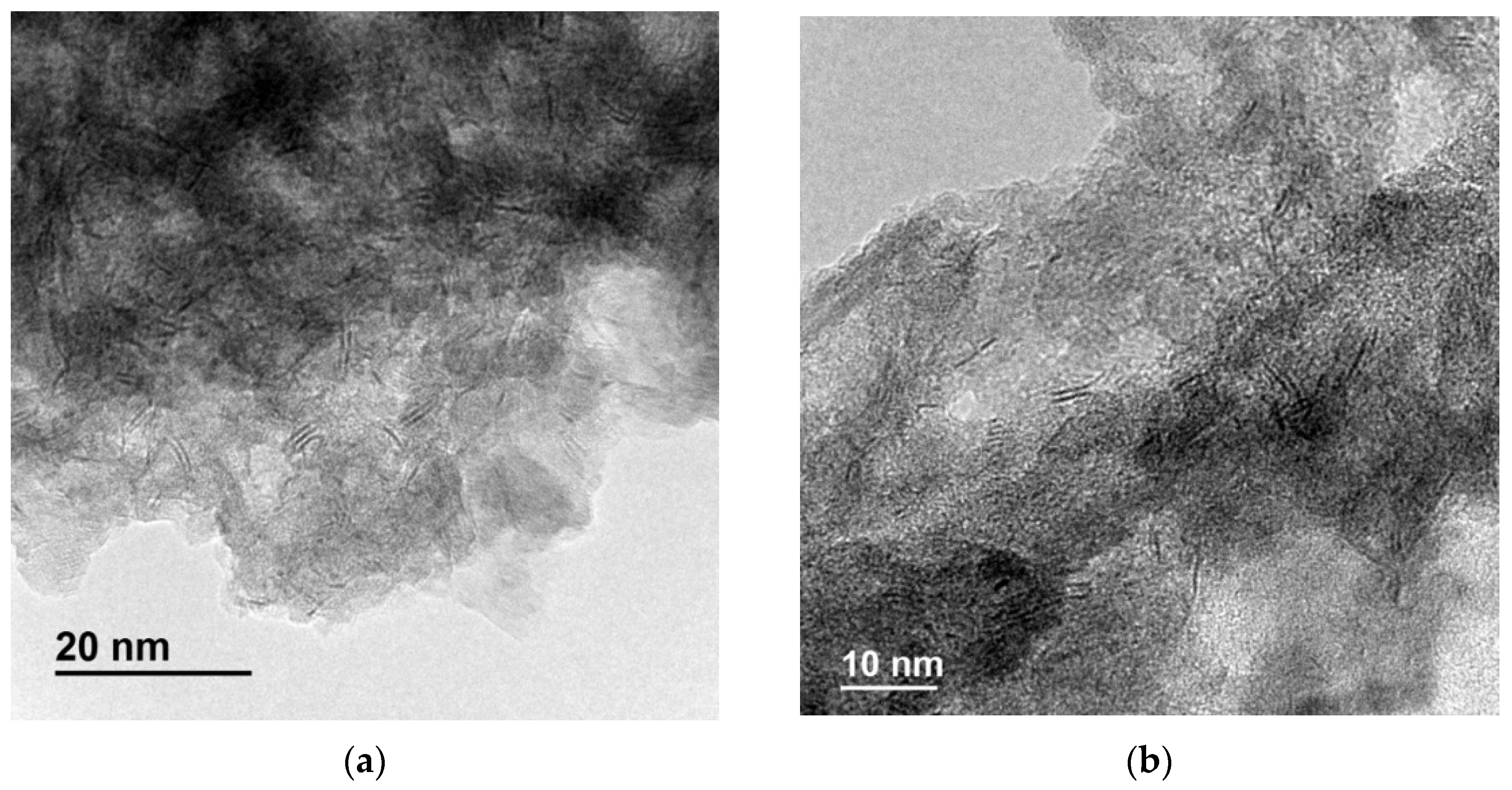
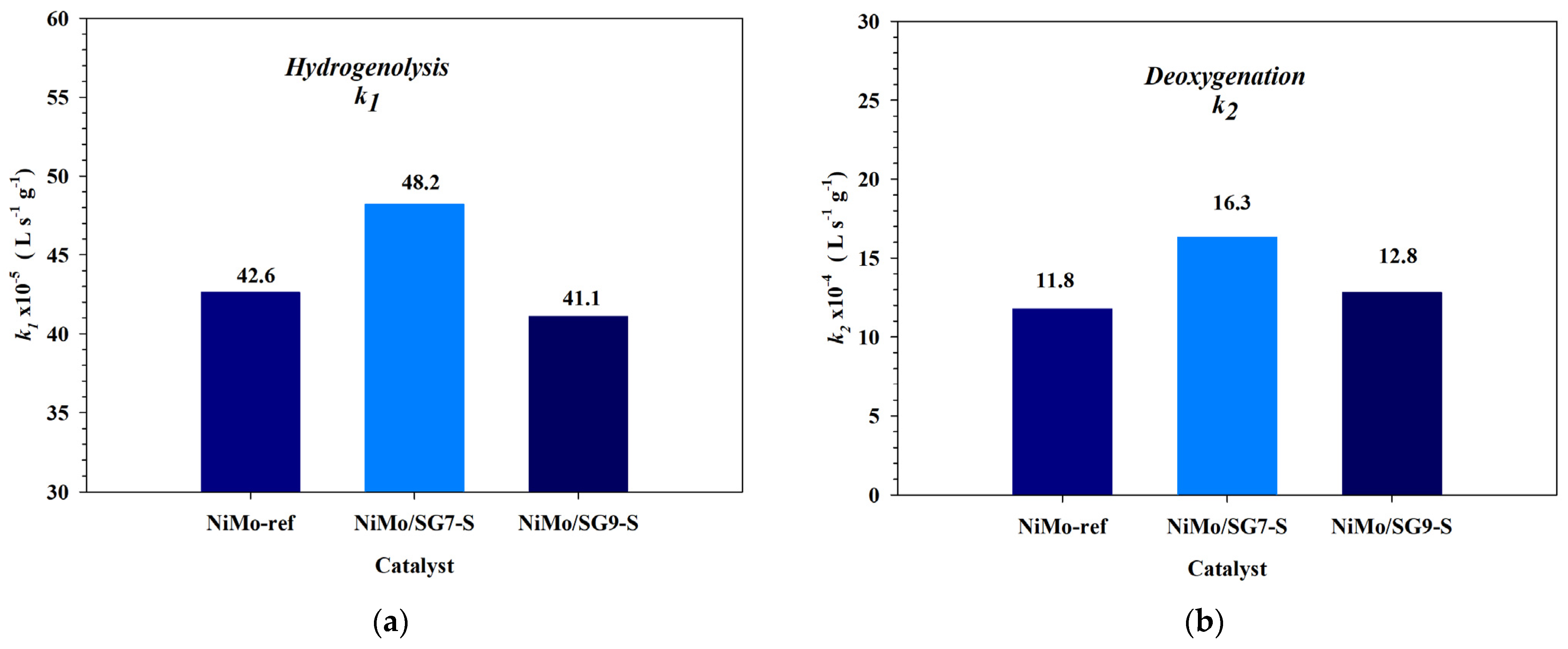
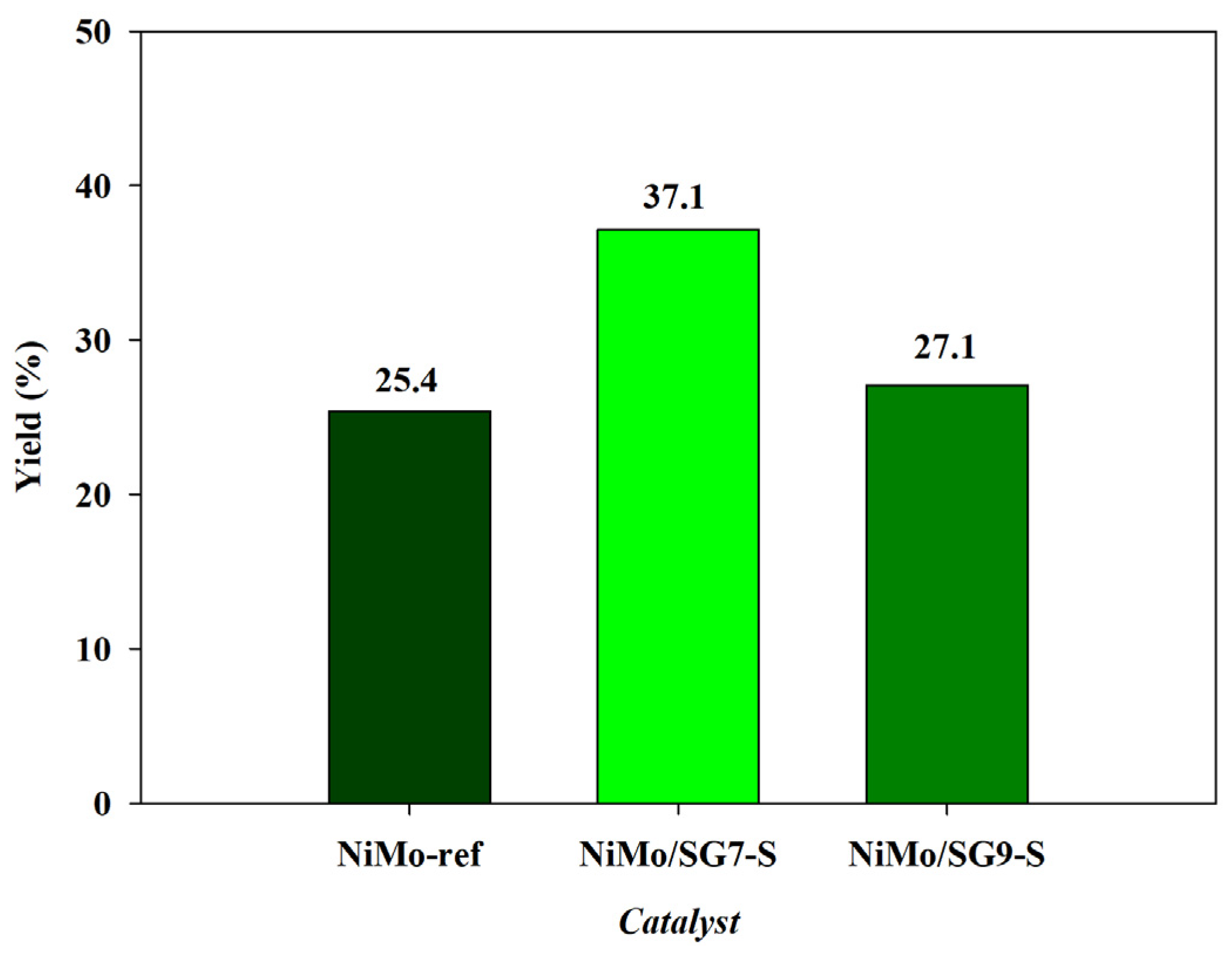
| Catalyst | Stacks per 1000 nm2 | N | L (nm) |
|---|---|---|---|
| NiMo/SG7-S | 10.9 | 1.56 | 2.91 |
| NiMo/SG9-S | 10.0 | 1.54 | 2.79 |
| Catalyst | n-C18 (mol%) | n-C17 (mol%) | n-C16 (mol%) | n-C15 (mol%) |
|---|---|---|---|---|
| NiMo/Al2O3-S | 7.3 | 77.3 | 4.8 | 10.3 |
| NiMo/SG7-S | 8.3 | 75.5 | 5.3 | 10.6 |
| NiMo/SG9-S | 10.3 | 74.3 | 5.9 | 9.2 |
Disclaimer/Publisher’s Note: The statements, opinions and data contained in all publications are solely those of the individual author(s) and contributor(s) and not of MDPI and/or the editor(s). MDPI and/or the editor(s) disclaim responsibility for any injury to people or property resulting from any ideas, methods, instructions or products referred to in the content. |
© 2025 by the authors. Licensee MDPI, Basel, Switzerland. This article is an open access article distributed under the terms and conditions of the Creative Commons Attribution (CC BY) license (https://creativecommons.org/licenses/by/4.0/).
Share and Cite
Mijares-Alvarado, A.G.; López-Benítez, A.; Silva-Rodrigo, R.; Rodríguez-Ávila, J.A.; Guevara-Lara, A. Impact of Impregnation pH on NiMo Surface Species in Al2O3-Supported Catalysts for Green Diesel Production. Surfaces 2025, 8, 21. https://doi.org/10.3390/surfaces8020021
Mijares-Alvarado AG, López-Benítez A, Silva-Rodrigo R, Rodríguez-Ávila JA, Guevara-Lara A. Impact of Impregnation pH on NiMo Surface Species in Al2O3-Supported Catalysts for Green Diesel Production. Surfaces. 2025; 8(2):21. https://doi.org/10.3390/surfaces8020021
Chicago/Turabian StyleMijares-Alvarado, Alexis G., Acela López-Benítez, Rebeca Silva-Rodrigo, José A. Rodríguez-Ávila, and Alfredo Guevara-Lara. 2025. "Impact of Impregnation pH on NiMo Surface Species in Al2O3-Supported Catalysts for Green Diesel Production" Surfaces 8, no. 2: 21. https://doi.org/10.3390/surfaces8020021
APA StyleMijares-Alvarado, A. G., López-Benítez, A., Silva-Rodrigo, R., Rodríguez-Ávila, J. A., & Guevara-Lara, A. (2025). Impact of Impregnation pH on NiMo Surface Species in Al2O3-Supported Catalysts for Green Diesel Production. Surfaces, 8(2), 21. https://doi.org/10.3390/surfaces8020021








